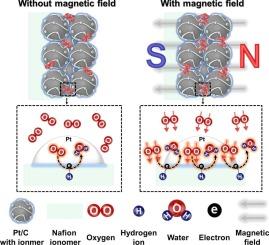Performance enhancement of oxygen reduction reaction in proton exchange membrane fuel cells using magnetic fields under various cathode design conditions
IF 7.6
Q1 ENERGY & FUELS
引用次数: 0
Abstract
Recent research efforts have focused on applying magnetic fields (MFs) to PEMFC (PEMFCMF) toward the enhancement of oxygen reduction reaction (ORR)-related performances. This study investigates the relationship between MF-induced spin-aligned oxygen and cathode design parameters, including the carbon-supported platinum weight ratio, ionomer-to-carbon weight ratio, and platinum loading amount. Morphology and electrochemical analyses of Pt/C catalysts are conducted to understand the effects of MFs on the ORR performance. The onset and half-wave potentials of the rotating disk electrode (RDE) with MFs are 28 and 45 mV higher, respectively, than those of the RDE without MFs, owing to the increased active oxygen species with aligned spins. The current increase rate of the PEMFCMF over the PEMFC is more substantial in the high-voltage region because of the enhanced ORR activity of the catalysts. Additionally, cathode designs of PEMFCMF are optimized to enhance its performance. The maximum performance increment of the optimized PEMFCMF compared to that of the PEMFC with a platinum loading amount of 0.5 mgpt cm−2 is 12.7 % at 0.7 V. These findings indicate that proper cathode designs can enhance the performance of PEMFCMF-based energy systems.

不同阴极设计条件下磁场增强质子交换膜燃料电池氧还原反应性能的研究
近年来的研究重点是将磁场(MFs)应用于PEMFC (PEMFCMF),以提高氧还原反应(ORR)相关性能。本研究探讨了mf诱导的自旋向氧与阴极设计参数的关系,包括碳负载铂的重量比、离聚体与碳的重量比和铂的装载量。对Pt/C催化剂进行了形貌和电化学分析,以了解MFs对ORR性能的影响。旋转圆盘电极(RDE)的起始电位和半波电位分别比不含MFs的RDE高28和45 mV,这是由于自旋排列的活性氧增加所致。在高压区,由于催化剂的ORR活性增强,PEMFCMF比PEMFC的电流增长速率更大。此外,还对PEMFCMF的阴极设计进行了优化,以提高其性能。在0.7 V电压下,与铂加载量为0.5 mgpt cm−2的PEMFCMF相比,优化后的PEMFCMF的最大性能增长为12.7%。这些发现表明,适当的阴极设计可以提高基于pemfcmf的能量系统的性能。
本文章由计算机程序翻译,如有差异,请以英文原文为准。
求助全文
约1分钟内获得全文
求助全文
来源期刊

Energy Conversion and Management-X
Multiple-
CiteScore
8.80
自引率
3.20%
发文量
180
审稿时长
58 days
期刊介绍:
Energy Conversion and Management: X is the open access extension of the reputable journal Energy Conversion and Management, serving as a platform for interdisciplinary research on a wide array of critical energy subjects. The journal is dedicated to publishing original contributions and in-depth technical review articles that present groundbreaking research on topics spanning energy generation, utilization, conversion, storage, transmission, conservation, management, and sustainability.
The scope of Energy Conversion and Management: X encompasses various forms of energy, including mechanical, thermal, nuclear, chemical, electromagnetic, magnetic, and electric energy. It addresses all known energy resources, highlighting both conventional sources like fossil fuels and nuclear power, as well as renewable resources such as solar, biomass, hydro, wind, geothermal, and ocean energy.
 求助内容:
求助内容: 应助结果提醒方式:
应助结果提醒方式:


